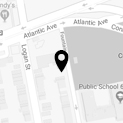#RedHotPatriot Backstage: Projecting Molly’s Life
Images from the life of Molly Ivins play an enormous role in Red Hot Patriot: The Kick-Ass Wit of Molly Ivins. As images pop up in different areas of the stage, Molly (played to critical acclaim by Karen MacDonald) reacts and shares biting and hilarious commentary with the audience. We interview the designer who makes these images come to life: Johnathan Carr.
Lyric Stage: Tell us how projections/images play a role in Red Hot Patriot?
Johnathan Carr: The setting of the play is what is referred to in the newspaper business as the “morgue”, the (usually basement) archival room where old news goes to slumber. As Molly recounts her life stories both personal and professional, images emerge, mostly through use of projection, but also physical photos/objects in the scene.

LS: How were you inspired to innovate the images to help tell the story?
JC: Upon reading the play it became apparent that nearly all of the images are meant to be actual photos from real-life Molly Ivins and the people, places and stories throughout her career. I knew that would be a task, and certainly doable, but from an artistic point-of-view it didn’t suggest much original design, just research. I wanted to involve design, but didn’t want compromise the historical integrity of the photos by manipulating them too much, so instead I opted to employ the “parallax” effect (also known as “The Kid Stays in the Picture” effect, after the documentary of the same name that popularized the technique). A 2D photo can be made to appear to have depth by separating foreground, mid, and background elements while moving a virtual camera through the scene to simulate 3D.
LS: What is your favorite image used in the show?
JC: The “Austin Fun House” sequence is probably my favorite. We found portraits of the 1981 Texas legislature arranged like a yearbook and Courtney asked if I could turn it into a shooting gallery. I love my job.

LS: How did you become interested in projection design?
JC: My background is primarily filmmaking which I’ve always considered a catch-all medium that can make use of or integrate with any other art form. It’s always been my practice to work on multiple formats because the skills and aesthetics that I pick up from one form can be applied to every other. Projection design (which truthfully I’d prefer be thought of as media/film/video design, as the term ‘projection’ doesn’t quite have the same elemental quality that ‘light’ and ‘sound’ have) was a natural progression of my mission to merge all forms in my work.
It’s always been my practice to work on multiple formats because the skills and aesthetics that I pick up from one form can be applied to every other.
LS: What other shows have you designed for at The Lyric Stage?
JC: Into the Woods (2014) and By the Way, Meet Vera Stark (2013).
LS: What advice do you have for people aspiring to work in professional technical theatre?
JC: The best advice for any work is to always be educating yourself, we should all think ourselves perpetual students of the world, that’s just a given.
If you live near a place theatre is being made, that is helpful. But also consider concerts, comedy shows, conventions, lectures, corporate events, fundraising galas — any live event that requires light/sound/video is a place to start learning, no matter the scale. Every theatre technician and designer I’ve known has traveled a very different path, which is really cool. Working on load-ins/strikes for pro theatre (or colleges) is one good way to start meeting theatre techs. Designing for smaller fringe/indie/community theatre is a way to start building a portfolio. And, alternatively, you could even produce your own show at a small venue (or in a festival/variety/revue) as a vehicle to exhibit your design chops under full creative control. Ambitious if you’re just starting out, but can be very effective for making connections.
Designing for smaller fringe/indie/community theatre is a way to start building a portfolio.
Generally I feel you should never repeat yourself, and always do the thing that is just outside your comfort/knowledge/skillset, Consider every project your own personal experiment, and whenever possible advance the medium. Do the research, gather many options, be ready to kill your darlings as they say, and do not take that personally. De gustibus non est disputandum. Most important is to listen to your director and your team, and also ensure they are understanding your ideas. A team with good chemistry will find a shorthand very quickly, but conversely a misperception or presumption of understanding can bring an entire production to a grinding halt. Communication is the greatest challenge in collaborative operations, exponentially so when speaking in the abstract as we designers must, so patience in achieving that mutual understanding is paramount.

